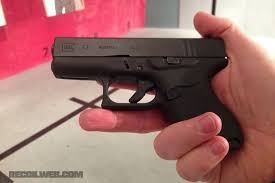My first introduction to the gun business was 1965 in North Carolina working for my Uncle Ben. Like all my immigrant relatives, Ben had been in the iron-mongering business back in the Old Country, so when he came to America he opened a junk yard where he traded scrap metal this for scrap metal that. At some point he started manufacturing a small, 22-caliber revolver which he sold to pawn shops for $15 bucks; the pawnbrokers then resold this little piece of junk for $24.95. This gun was a quintessential ‘Saturday Night Special,’ which might fire one or two shots before it broke.
So here we are, fifty years later, and Uncle Ben’s cheap, little piece of junk for $24.95 has been replaced by, among other models, the Glock 43, which retails for somewhere around five hundred bucks. But the Glock 43, which is actually smaller and more concealable than Uncle Ben’s crummy, little gun, isn’t a 22-caliber revolver with a capacity of six shots. It’s an extremely-lethal 9mm pistol which holds seven rounds and with a magazine extension the capacity goes up to nine. If you’re not enamored with Glock, other gun companies like Ruger and Kahr make 9mm pistols which are basically the same capacity and size.
What has happened to the gun business over the last half century is the guns have gotten smaller, lighter, more concealable and much more lethal. When Franklin Zimring did a study of the calibers found in 1,115 gun attacks in Chicago in 1970, he found that gun attacks with 38-caliber weapons were more than twice as fatal as attacks committed with 22-caliber guns. When the California Department of Justice published a list of calibers that caused gun injuries in 2009, five times as many guns were used in high-powered calibers like 9mm, 40 S&W and 45 acp than guns chambered for the 22. You simply can’t compare the damage to human tissue caused by a 9mm round as opposed to a 22-caliber shell. The latter can be lethal if, and only if the shooter is either extremely lucky or is a very good shot. As for a 9mm or a 40 round, if it hits you anywhere except in your earlobe, you’re going down.
Back in 1968 and again 1994, we passed gun-control laws based on the idea that we could reduce gun violence by keeping guns out of the ‘wrong’ hands. Which meant keeping guns away from people whose background and behavior indicated that they might represent a threat to public safety or themselves if they could get their hands on a gun. The current effort to extend background checks to secondary sales is an effort to strengthen our ability to identify more ‘wrong’ hands, as are the strategies designed to tighten the regulatory environment in which gun dealers operate so as to keep ‘bad apple’ dealers from selling guns to people with ‘wrong hands.’
I happen to believe that this approach, while necessary, actually doesn’t respond to the primary cause of gun violence, namely, the degree to which most guns sold today are capable of being used to commit a much higher level of gun violence than ever before. There is a bill before Congress that recognizes the lethality of assault rifles and is an effort to revive the assault-weapons ban that expired in 2004. But while this law reflects concerns about the lethality of the AR-style gun, pro-gun advocates are not wrong when they say that, mass shootings notwithstanding, injuries caused by AR-15’s are relatively few and far between.
Know what causes most of the 115,000+ fatal and non-fatal gun injuries each year? It’s those small but powerful handguns which are increasingly the weapons of choice for most Americans who own guns. So instead of spending all our time, energy and money trying to keep guns out of the wrong hands, shouldn’t we also be trying to figure out how to keep the wrong guns out of everyone’s hands?

Oct 25, 2024 @ 11:40:46
So you are suggesting we ban “… the weapons of choice for most Americans who own guns…”
Sounds like a tough sell.
Nov 01, 2024 @ 21:31:07
Reblogged this on Mister Journalism: "Reading, Sharing, Discussing, Learning".